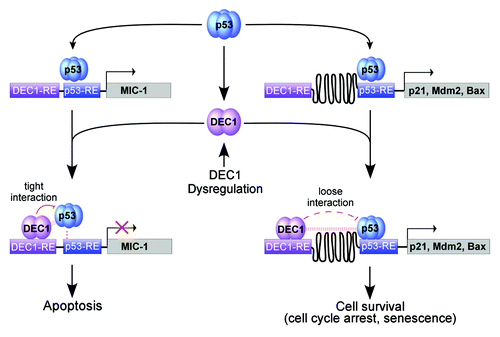Figures & data
Figure 1. A model for DEC1 to differentially modulate p53-dependent gene expression. Upon binding to the p53-responsive element (p53-RE), p53 induces an arrary of pro-survival and pro-apoptotic genes, including p21, Mdm2, Bax, MIC-1 and DEC1. Since the p53-RE is adjacent to the DEC1-RE on the MIC-1 promoter, p53 and DEC1 interact tightly on the MIC-1 promoter, which then weakens the ability of p53 to bind to the MIC-1 promoter and consequently p53-induction of MIC-1. By contrast, due to a large space between the DEC1-RE and the p53-RE on the promoters of other p53 target genes, including p21, Mdm2 and Bax, the interaction between DEC1 and p53 on the target gene promoters is too weak to inhibit p53 DNA-binding activity. Therefore, DEC1 does not inhibit the ability of p53 to induce p21, Mdm2 and Bax. Together, we hypothesize that DEC1 forms a feedback loop with p53 to control the response of DNA damage-induced cell survival vs. cell death via MIC-1 and that dysregulation of DEC1 alters the sensitivity of tumors to cancer therapies via the p53-DEC1-MIC-1 loop.
